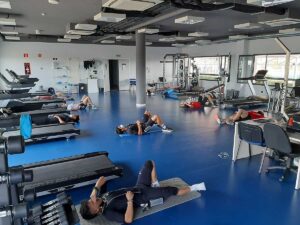On several occasions, we have analyzed how whole-body electrostimulation affects different sports like crossfit, running or golf.
Aerobic exercise, together with strength exercise, are the two main pillars of sports practice, whether for fun, performance or entertainment (1).
Both variables indicate, in a global way, a person’s health and physical fitness (2). This time, we are going to focus on the project called Electrifitty, a project carried out at the Wiems Lab in which we separated a group of young men and women to perform: on the one hand, conventional cardiovascular exercise and on the other hand continuous aerobic exercise with an electrostimulation vest.
Electrifitty: The Study
The idea for this project arose from the use of whole-body electrostimulation developed at Wiemspro.
Unlike traditional WB-EMS, we are committed to an undulating periodization where the different electrical parameters are combined in order to work all the muscle fibers of the body. This undulating periodization has been previously shown to have benefits (3). The use of low frequencies can help to increase the recruitment of slow fibers, thus simulating cardiovascular training. That is why we decided to use the electrostimulation suit while performing aerobic exercise for a total of 4 weeks in healthy young people.
Objective of the study
The objective of this intervention was to test whether WB-EMS had an added effect on the improvements in body composition and on cardiovascular fitness after 4 weeks of training 4 days a week.
Study hypothesis
Our hypothesis was that WB-EMS added to voluntary aerobic exercise could, on the one hand, increase energy expenditure, and on the other hand, improve cardiovascular fitness to a greater extent than if we performed the exercise without the electrostimulation suit.
Target audience of the study
First, it is worth noting that the target population of this study was healthy young adults aged between 20-30 years with no diagnosed pathologies. We thought it was convenient to carry out the study in a young population with the goal finding out the level of physical condition of the population in this age range, taking into account the lifestyle followed in this period.
We had a total of 19 adults (52.6% female) with a mean age of 26.6 ± 6.5 years and no previous experience in EMS training. The following table shows the descriptive data for this population:

The data show that we are dealing with a generally young population 26.6 ± 6.5 years old. Regarding the separation between the groups, we may think that the age difference between the groups is high, however, we did not find differences between the groups in any of the variables measured before the study. This means that both groups were balanced and both had similar participants. The distribution of women and men was also similar in both groups (40-60% of each sex in both groups).
It should be noted that fat mass measured in % was quite high in both groups.
- The aerobic training group had a mean fat % of 38.2 ± 4.5.
- The aerobic training group had a mean fat % of 38.2 ± 4.5.
These data indicate that both groups started from a high level of fat % due to a rather sedentary lifestyle. Prior to the intervention, we sent all participants several questionnaires related to sedentary behavior, self-perceived fitness and quality of life. These questionnaires provide us with information on previous physical condition and health status.
A test was also performed to determine the cardiovascular fitness of both groups.
- The aerobic exercise group without electrostimulation obtained a mean of 45.0 ± 3.3 ml/kg/min.
- The aerobic exercise group with electrostimulation obtained values of 43.3 ± 5.5 ml/kg/min.
There were no significant differences between the two groups, although we can confirm that these levels were not optimal.

Study plan
The intervention for this study lasted a total of 4 weeks.
The participants were divided into two groups in order to isolate the effects of WB-EMS from the effect of the exercise itself. Both groups performed the same type of exercise and at the same intensity with the difference that some used the electrostimulation suit at all times, and others did not.
Both groups trained 4 times per week (i.e., Monday, Tuesday, Thursday and Friday) and jointly. That is, people with and without vests trained together. The training sessions were carried out on a cycle ergometer and on the elliptical trainer in a randomized and controlled manner.
In order to explain and understand the training plan, we must keep in mind that there were two types of external stimuli.
First, the external stimulus of voluntary exercise itself was individually adjusted to 60-65% of each participant’s heart rate reserve. Both ergometer resistance and pedaling cadence were controlled so that they always remained within the pulse rate range previously mentioned.
On the other hand, the external intensity of electrostimulation was divided into two types of program. One, oriented to cardiovascular training with a greater predominance of slow fiber activation, and the other oriented to neuromuscular training with a predominance of fast fiber activation.
Study Results
Those without the WB-EMS suit in place performed a fully aerobic workout, while those with the WB-EMS suit performed concurrent exercise.
All sessions were recorded by an OH 1 heart rate monitor to ensure that participants trained at the intensity they were supposed to.

What does electrostimulation contribute to this process?
We assume that WB-EMS provides a higher energy expenditure in each of the sessions. This increase in energy expenditure, in principle, should translate into a greater decrease in fat % and weight. Likewise, an involuntary contraction triggered by EMS could have an effect on strength gains, but, above all, on health parameters that we were unable to measure in this intervention, such as glucose uptake, motor fiber recruitment, and increased muscle contraction.
WB-EMS elevates heart rate, and also has an effect on body composition and physical condition.
Conclusion
To sum up, we see that this intervention was planned with the aim of isolating the effects of WB-EMS on exercise, and to see what repercussions it might have.
The descriptive data of the sample indicate that we are dealing with a group of young people, physically inactive, with a highly sedentary lifestyle and with a fat % that indicates a poorly managed diet.
Adherence to training for this type of person is key to achieving goals. In this sense, the WB-EMS provided an added motivation, as no one missed a training session. There was a 100% follow-up of the training sessions.
On the other hand, we can confirm that 4 days a week of WB-EMS did not cause injuries or any type of physical problem, such as stiffness or injuries, for any of the participants. Electrostimulation training of more than 20 minutes has no effect on CK levels therefore, this training program with electrostimulation 4 days a week for an average of 45 minutes per session does not have a negative impact on health.
Unai Adrian Perez de Arrilucea
Wiems Lab Team
References
- Knuttgen HG. Strength training and aerobic exercise: comparison and contrast. The Journal of Strength & Conditioning Research. 2007;21(3):973-8.
- Voet NB, van der Kooi EL, van Engelen BG, Geurts AC. Strength training and aerobic exercise training for muscle disease. Cochrane Database of Systematic Reviews. 2019(12).
- Amaro-Gahete FJ, De-la-O A, Sanchez-Delgado G, Robles-Gonzalez L, Jurado-Fasoli L, Ruiz JR, et al. Functional exercise training and undulating periodization enhances the effect of whole-body electromyostimulation training on running performance. Frontiers in physiology. 2018;9:720.







